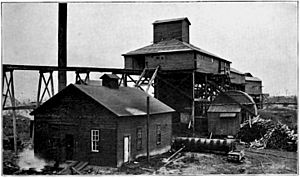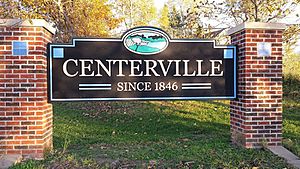Centerville, Iowa facts for kids
Quick facts for kids
Centerville
|
||
|---|---|---|
|
City
|
||
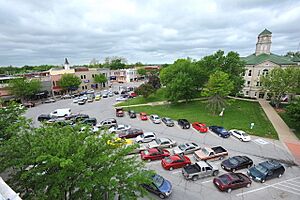
Appanoose County Courthouse and the Centerville Square
|
||
|
||
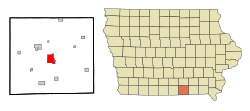
Location of Centerville, Iowa
|
||
| Country | ||
| State | ||
| County | Appanoose | |
| Area | ||
| • Total | 4.87 sq mi (12.60 km2) | |
| • Land | 4.84 sq mi (12.53 km2) | |
| • Water | 0.03 sq mi (0.08 km2) | |
| Elevation | 1,007 ft (307 m) | |
| Population
(2020)
|
||
| • Total | 5,412 | |
| • Density | 1,118.88/sq mi (432.00/km2) | |
| Time zone | UTC−6 (Central (CST)) | |
| • Summer (DST) | UTC−5 (CDT) | |
| ZIP Code |
52544
|
|
| Area code(s) | 641 | |
| FIPS code | 19-12315 | |
| GNIS feature ID | 467589 | |
Centerville is a city in Appanoose County, Iowa. It is also the main city, or county seat, of the county. In 2020, about 5,412 people lived there. This was a bit less than the 5,924 people who lived there in 2000.
Around the early 1900s, many people from Europe moved to Centerville. They came from countries like Sweden, Italy, Croatia, and Albania. They came to work in the city's coal mines. Centerville is also famous for having the biggest town square in all of Iowa!
Contents
History
Early Days
Centerville was started in 1846 by Jonathon Stratton. He first called it "Chaldea." The city was planned around a special town square that was two blocks long. Later, the name was changed to Senterville. This name honored William Tandy Senter, a well-known politician from Tennessee. When the city officially became a town in 1855, someone thought "Senterville" was spelled wrong. They changed it to Centerville, and the name stuck!
Coal Mining Era
The first coal mine in Centerville opened in 1868. It was about half a mile from the train station. At first, horses pulled the coal out of the mines. But in 1872, the Watson Coal Company opened a new mine. It used a steam-powered machine called a hoist to lift the coal.
The Centerville Block Coal Company started in 1894. It brought many mines in the area together. This made it the biggest mining company. In 1914, this company produced over 100,000 tons of coal. This made it one of the top coal producers in Iowa. Another big company was the Scandinavian Coal Company. It was started by Swedish immigrants. By 1938, the Centerville area was producing 600,000 tons of coal each year. The coal mines were about 125 feet underground.
Life in the Mines
The Relay Mine Number 3 was on the west side of Centerville. By 1908, the coal was being dug out about a mile from the main shaft. Mules helped by pulling carts of coal to the main path. From there, a moving cable system pulled them the rest of the way to the shaft. The coal layer was about 3 feet thick. The main shaft went down 107 feet. A large fan helped with air flow. Machines used compressed air to help with the mining work.
Miners' Rights
Miners in Centerville joined groups to protect their rights. In 1884, a group called Local Assembly 1020 of the Knights of Labor had 150 members. On April 1, 1885, 325 miners in town went on strike. They were protesting a 20% pay cut. This cut happened because less coal was needed in the summer. Later, the United Mine Workers of America (UMWA) was very strong in Centerville. In 1912, UMWA Local 553 in Centerville had 1194 members. This made it the second largest UMWA group in the whole country!
Other Discoveries
In 1910, the Scandinavian Coal Company drilled a deep hole in Centerville. They found a layer of gypsum and anhydrite about 10 feet thick. These are minerals used in building materials. The Centerville Gypsum Company was formed to dig up these minerals. They started a mine between 1912 and 1913. Water problems delayed the mine's opening until 1917. They started selling the minerals in 1919. The mine closed in the early 1930s.
The Sunshine mine was about 3 miles west of Centerville. In 1908, it was small and used horses to lift things. By the 1930s, it was a large mine with a mining camp. A drive-in movie theater called the Sunshine Mine Drive-In opened on the old mine site in 2005. It has since closed down.
After Coal Mining
Centerville had its largest population when coal mining was at its peak. But as coal became less popular, the mining industry in Centerville collapsed. In the 1950s and 1960s, people in the city worked to bring in new businesses. This led to the building of Rathbun Dam. It created Rathbun Lake, which is known as "Iowa's Ocean." President Richard M. Nixon officially opened it on July 31, 1971.
In 2006, the city's biggest employer, a Rubbermaid factory, closed down. This meant 500 workers lost their jobs. The factory had opened in Centerville in 1985. In 2007, Lee Container bought the old Rubbermaid building. They make plastic containers there.
The Southern Iowa Railroad was an electric train line. It connected Centerville to Moravia and Mystic. It stopped running in 1967. The Appanoose County Community Railroad (APNC) started in 1984. It used old train tracks and connected to a bigger railroad. The Iowa Southern Railway took over in 2016 and still provides train service to the city.
What Centerville is Like
Centerville is in south-central Iowa. It is where Iowa Highway 2 and Iowa Highway 5 meet. The city covers about 4.89 square miles. Most of this area is land, with a small part being water.
Weather in Centerville
Centerville has a climate with hot summers. This means it has warm, humid summers and cold winters.
| Climate data for Centerville, Iowa, 1991–2020 normals, extremes 1893–present | |||||||||||||
|---|---|---|---|---|---|---|---|---|---|---|---|---|---|
| Month | Jan | Feb | Mar | Apr | May | Jun | Jul | Aug | Sep | Oct | Nov | Dec | Year |
| Record high °F (°C) | 80 (27) |
78 (26) |
90 (32) |
90 (32) |
101 (38) |
104 (40) |
110 (43) |
110 (43) |
106 (41) |
94 (34) |
81 (27) |
74 (23) |
110 (43) |
| Mean maximum °F (°C) | 55.5 (13.1) |
59.7 (15.4) |
73.6 (23.1) |
81.5 (27.5) |
86.1 (30.1) |
90.6 (32.6) |
91.4 (33.0) |
93.9 (34.4) |
89.5 (31.9) |
82.2 (27.9) |
70.1 (21.2) |
59.4 (15.2) |
95.2 (35.1) |
| Mean daily maximum °F (°C) | 32.7 (0.4) |
37.7 (3.2) |
50.5 (10.3) |
62.9 (17.2) |
72.3 (22.4) |
81.5 (27.5) |
85.8 (29.9) |
84.3 (29.1) |
76.3 (24.6) |
64.4 (18.0) |
50.3 (10.2) |
38.0 (3.3) |
61.4 (16.3) |
| Daily mean °F (°C) | 22.3 (−5.4) |
26.8 (−2.9) |
38.5 (3.6) |
50.0 (10.0) |
60.3 (15.7) |
70.3 (21.3) |
74.5 (23.6) |
72.6 (22.6) |
64.2 (17.9) |
52.5 (11.4) |
39.1 (3.9) |
28.1 (−2.2) |
49.9 (10.0) |
| Mean daily minimum °F (°C) | 12.0 (−11.1) |
16.0 (−8.9) |
26.5 (−3.1) |
37.1 (2.8) |
48.4 (9.1) |
59.1 (15.1) |
63.1 (17.3) |
60.9 (16.1) |
52.1 (11.2) |
40.6 (4.8) |
27.9 (−2.3) |
18.2 (−7.7) |
38.5 (3.6) |
| Mean minimum °F (°C) | −7.5 (−21.9) |
−2.5 (−19.2) |
8.9 (−12.8) |
24.3 (−4.3) |
36.3 (2.4) |
48.7 (9.3) |
56.3 (13.5) |
53.6 (12.0) |
39.7 (4.3) |
27.0 (−2.8) |
13.1 (−10.5) |
0.8 (−17.3) |
−11.6 (−24.2) |
| Record low °F (°C) | −30 (−34) |
−24 (−31) |
−17 (−27) |
6 (−14) |
27 (−3) |
39 (4) |
45 (7) |
39 (4) |
23 (−5) |
0 (−18) |
−11 (−24) |
−28 (−33) |
−30 (−34) |
| Average precipitation inches (mm) | 0.99 (25) |
1.26 (32) |
2.15 (55) |
3.88 (99) |
5.22 (133) |
4.71 (120) |
3.45 (88) |
3.86 (98) |
3.85 (98) |
3.01 (76) |
2.19 (56) |
1.46 (37) |
36.03 (917) |
| Average snowfall inches (cm) | 7.1 (18) |
5.0 (13) |
3.2 (8.1) |
1.7 (4.3) |
0.0 (0.0) |
0.0 (0.0) |
0.0 (0.0) |
0.0 (0.0) |
0.0 (0.0) |
0.3 (0.76) |
1.9 (4.8) |
2.3 (5.8) |
21.5 (54.76) |
| Average precipitation days (≥ 0.01 in) | 5.3 | 6.2 | 6.7 | 9.2 | 11.4 | 9.8 | 7.1 | 7.9 | 6.8 | 7.8 | 6.2 | 5.1 | 89.5 |
| Average snowy days (≥ 0.1 in) | 3.2 | 3.4 | 1.4 | 0.4 | 0.0 | 0.0 | 0.0 | 0.0 | 0.0 | 0.2 | 0.8 | 2.0 | 11.4 |
| Source 1: NOAA | |||||||||||||
| Source 2: National Weather Service | |||||||||||||
People of Centerville
| Historical population | ||
|---|---|---|
| Year | Pop. | ±% |
| 1850 | 1,137 | — |
| 1860 | 509 | −55.2% |
| 1870 | 1,037 | +103.7% |
| 1880 | 2,475 | +138.7% |
| 1890 | 3,668 | +48.2% |
| 1900 | 5,256 | +43.3% |
| 1910 | 6,936 | +32.0% |
| 1920 | 8,486 | +22.3% |
| 1930 | 8,147 | −4.0% |
| 1940 | 8,413 | +3.3% |
| 1950 | 7,625 | −9.4% |
| 1960 | 6,629 | −13.1% |
| 1970 | 6,531 | −1.5% |
| 1980 | 6,558 | +0.4% |
| 1990 | 5,936 | −9.5% |
| 2000 | 5,924 | −0.2% |
| 2010 | 5,528 | −6.7% |
| 2020 | 5,412 | −2.1% |
| Iowa Data Center Source: U.S. Decennial Census |
||
How Many People Live Here?
In 2020, there were 5,412 people living in Centerville. There were 2,378 households, which are groups of people living together. About 25% of these households had kids under 18. The average age of people in Centerville was 42.3 years old. About 24% of the people were under 20.
In 2010, there were 5,528 people. About 27% of households had kids under 18. The average age was 41.8 years.
Jobs and Businesses
Many people in Centerville work for different companies. Here are some of the biggest employers in 2019:
| Employer | Size Class |
|---|---|
| Barker Co. Ltd | 250-499 |
| Lee Container | 100-249 |
| Mercy One Centerville Medical Center | 100-249 |
| Centerville Community School District (and affiliated schools) | 100-249 |
| Walmart Supercenter | 100-249 |
| Hy-Vee | 100-249 |
| Fareway | 100-249 |
| C&C Machining | 50-99 |
Fun Things to Do
Pancake Day Festival
Since 1949, Centerville has held an annual Pancake Day festival. It used to be in October, then September. Now, it's held on the last Saturday in September. On Pancake Day, local businesses give out free pancakes to thank their customers.
The event takes place in the Courthouse Square. It has a parade for kids in the morning. There's a bigger parade in the afternoon with a special route. There's also a beauty queen contest and free shows. In 2021, Centerville set a Guinness World Record. They served 14,000 pancakes in just four hours! Many famous people have visited Pancake Day. These include politicians like Estes Kefauver and W. Averell Harriman. Famous entertainers like Barbara Mandrell have also been there.
Croatian Fest
From 1987 to 2008, Centerville also hosted the Croatian Fest.
Schools and Learning
The schools in Centerville are part of the Centerville Community School District. The schools include:
- Centerville High School
- Howar Middle School
- Lakeview Elementary School
Central Ward Elementary closed in 2020. Its students moved to Lakeview Elementary.
High School History
The first person to graduate from Centerville High School was Jennie Drake in 1876. She was the daughter of Francis M. Drake, who was once the Governor of Iowa. The first African-American student to graduate was Joseph Edwin Herriford in 1885.
College in Centerville
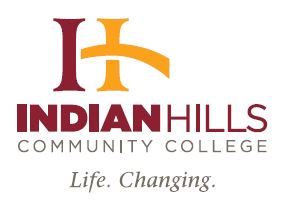 Centerville is home to a campus of Indian Hills Community College. This is a two-year college. It started in 1930 as Centerville Junior College. In 1970, it became the Centerville Campus of Indian Hills Community College. The main campus of Indian Hills Community College is in Ottumwa, Iowa. The current Centerville campus was built in 1970.
Centerville is home to a campus of Indian Hills Community College. This is a two-year college. It started in 1930 as Centerville Junior College. In 1970, it became the Centerville Campus of Indian Hills Community College. The main campus of Indian Hills Community College is in Ottumwa, Iowa. The current Centerville campus was built in 1970.
Media and Entertainment
Local News
The local newspaper in Centerville is the Appanoose Weekly.
TV and Online Shows
The Iowa Media Network is in Centerville. They run GoPitchTV. This is an online TV station that covers Appanoose County. GoPitchTV broadcasts live events on Facebook Live and through its app and website.
Radio Stations
AM
- KCOG 1400 plays oldies music.
FM Radio
- KMGO 98.7 plays country music.
- KCOG 103.9 re-broadcasts the KCOG 1400 AM signal.
Movies Filmed Here
- The independent movie Iowa (2005) was filmed in Centerville. It starred Matt Farnsworth and Rosanna Arquette.
- Part of the silent movie The Wonderful Thing (1921) was filmed in Centerville and Appanoose County. It starred Norma Talmadge.
Getting Around Centerville
Roads and Trains
Iowa Highway 2 goes through Centerville from east to west. Iowa Highway 5 goes through from north to south.
The Iowa Southern Railway (ISRY) provides train service. It connects with larger train lines like BNSF, CP, and NS.
Airport and Utilities
The Centerville Municipal Airport is on the southwest side of Centerville.
Alliant Energy provides electricity and gas to the city. Companies like Windstream Holdings, Mediacom, and Natel offer cable TV, home phone, and internet. The Rathbun Regional Water Association provides drinking water. Centerville Municipal Water handles water and sewer services. There are also private companies for trash removal. You can recycle at the Rathbun Area Solid Waste Commission.
Famous People from Centerville
- Manuel Bromberg, an artist
- John Bushemi, a photographer
- Francis M. Drake, a former Governor of Iowa
- Richard Dudman, a journalist
- Simon Estes, a famous opera singer
- Mack Garner, a jockey in the Hall of Fame
- Jonathan Mathews, a professional baseball coach
- Rick Mathews, a professional baseball coach and scout
- Harry J. Middleton, a journalist and museum director
- Mike Morris, a professional football player
- Claude Payton, an actor
- Claude R. Porter, a government official
- Edna May Spooner, an actress
- H.N. Swanson, a literary agent
- Andrew W. Tibbets, a Medal of Honor winner from the American Civil War
- John K. Valentine, a former Lieutenant Governor of Iowa
- Himie Voxman, a clarinet player
- Madison M. Walden, a former Lieutenant Governor of Iowa
See also
 In Spanish: Centerville (Iowa) para niños
In Spanish: Centerville (Iowa) para niños





